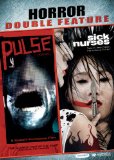Pulse:
Plenty of Japanese horror films have storylines that vary from the oblique to the opaque. Pulse is no exception, so forgive me if this synopsis is a bit confusing (or confused). An internet website offers visitors the chance to see actual ghosts. Viewing the footage seems to make one vulnerable to an actual visitation, and when someone encounters a ghost, that person withdraws from others, shunning all society, and becomes consumed by loneliness to the point of suicide or something even more bizarre. All of this is slowly being uncovered by two groups of friends, even as the plague of ghostly encounters spreads far and wide.
The narrative is disjointed, and tracking the characters and knowing who is connected to whom can be a challenge. But then, this can also be said of nightmares (when was the last time you had one with a coherent narrative?), and Pulse is nothing if not nightmarish, in every sense of the word. Both story and atmosphere are dream-like; we are for the most part spared the long-haired female ghosts that became such clichés after this film was made (2001), and the mounting sense of apocalypse is something one rarely sees in a ghost story, but boy, does it work here.
Sick Nurses (Suay Laak Sai):
A doctor in a rundown hospital building has a staff of young sexy nurses to help him with his side business. It seems there is a market for the bodies of young girls somewhere out there. The group disposes of the folks and makes some money on the corpse. They have a pretty good thing going for them until one of them decides to spill the beans because her sister has stolen her guy. The only thing left for the girls to do is to kill the potential narc and add one more body sale to the day’s receipts. It all appears to be going well. Then on the 7th day of our young victim’s death, strange things begin to happen. Our young nurse is out for revenge, so the anticipated bloodbath begins in earnest.
This one has all of the fetishes of the Asian ghost story formula. There’s plenty of long black hair. The hair turns out to be a good material for wrapping and suffocating young nurses. There is the thin slinky dark creature that moves in odd jerky motions. What makes this film a bit more than the usual Asian stuff is the almost American setting. The nymphette cast and the slasher mentality almost looks like it could have come from any of a number of cheap independent American films. The blood effects are everywhere, and this is not a film for the squeamish. There is far more gore than you might expect from the genre. Some of it is pretty good. There are some rather badly rendered CG effects, however. The worst involves a CG decapitation that is one of the worst horror effects I think I’ve seen in a long time.
Video
The colors are very dark here, verging on the muddy, but this is, as far as I can tell, deliberate. The result is certainly a very moody feel for the movie, adding to its oppressive sense of despair. There are a few scenes, however, where the murk does get in the way of properly seeing what is going on. There is also a fair bit of grain. Deliberate too? Hard to say. The aspect ratio is a 1.78:1 anamorphic widescreen.
Audio
Brrrrrr….. creepy. The audio track is immersive in the most disturbing of ways. The environmental sounds are constant, even when they are little more than the industrial white noise of the city, and the score delivers some very nasty shocks during the ghost scenes. There is one odd flaw which, though not a problem with the sound itself, is related to it, so I raise it here: the subtitles trail about a second behind the dialog. Pulse is only available in Japanese. Sick Nurses is available in English or Thai.
Special Features
Nothing.
Final Thoughts:
All in all it’s a pretty nice double-feature sampling of Asian horror films. Both are unique in their way and represent more of the genre’s cutting edge with perhaps some American influences showing through the seems. You get a good sense of the style that has been the inspiration for such a trend of remakes here in the United States. Sometimes these remakes get so ridiculous that you just want to scream, “No more”.
Parts of this review were written by David Annandale.




